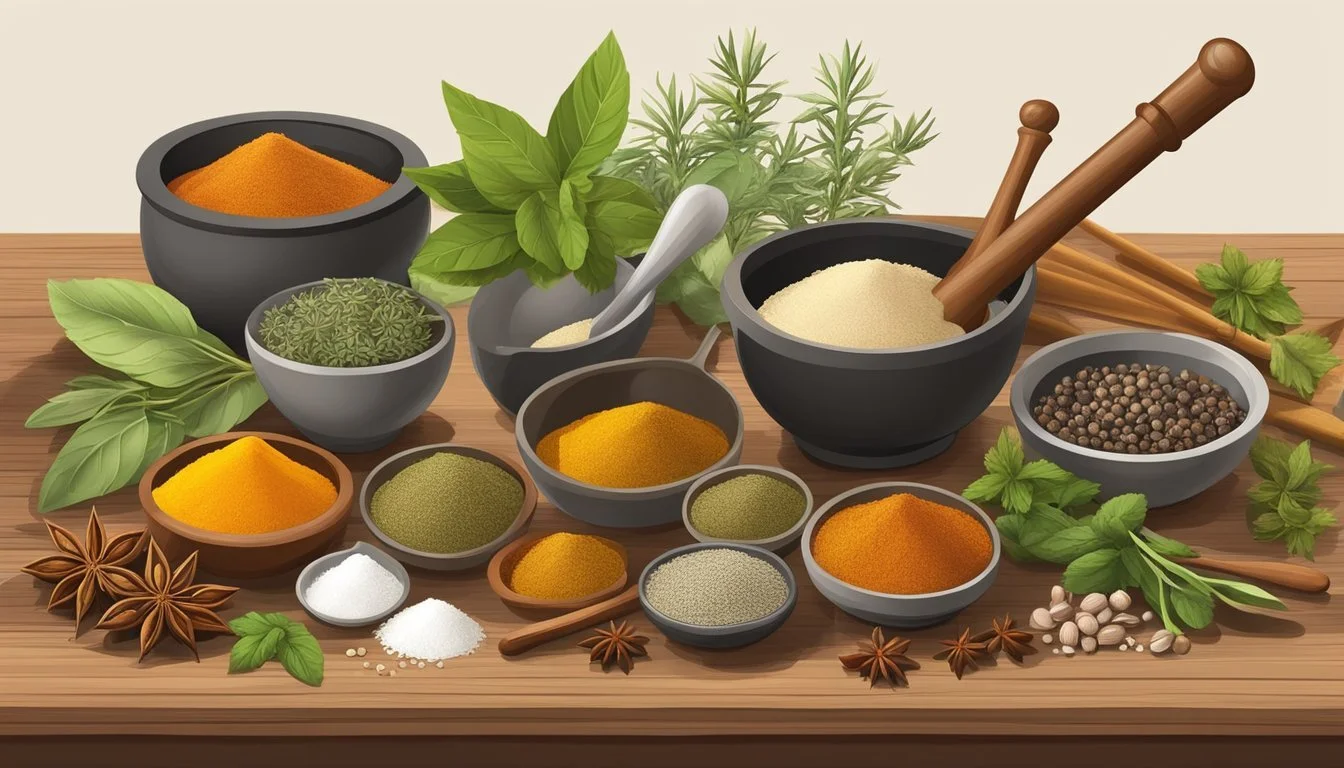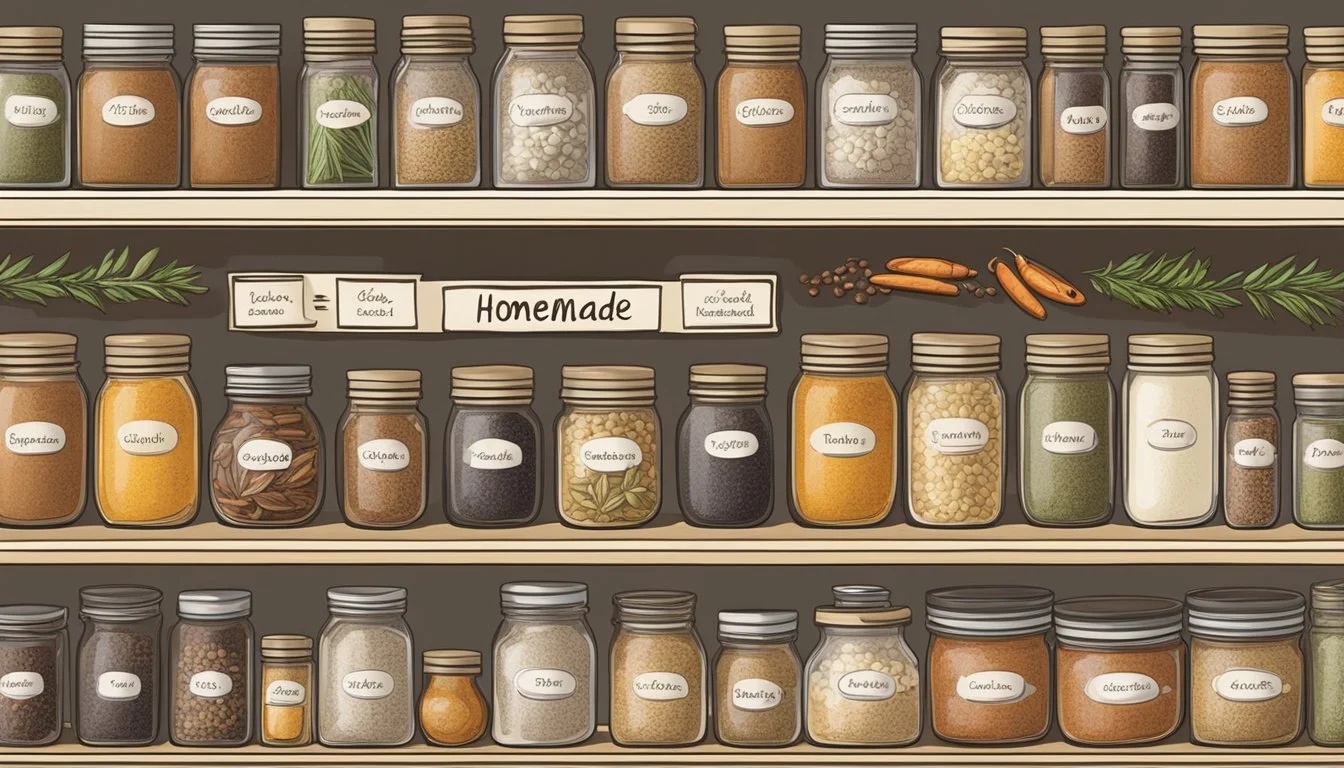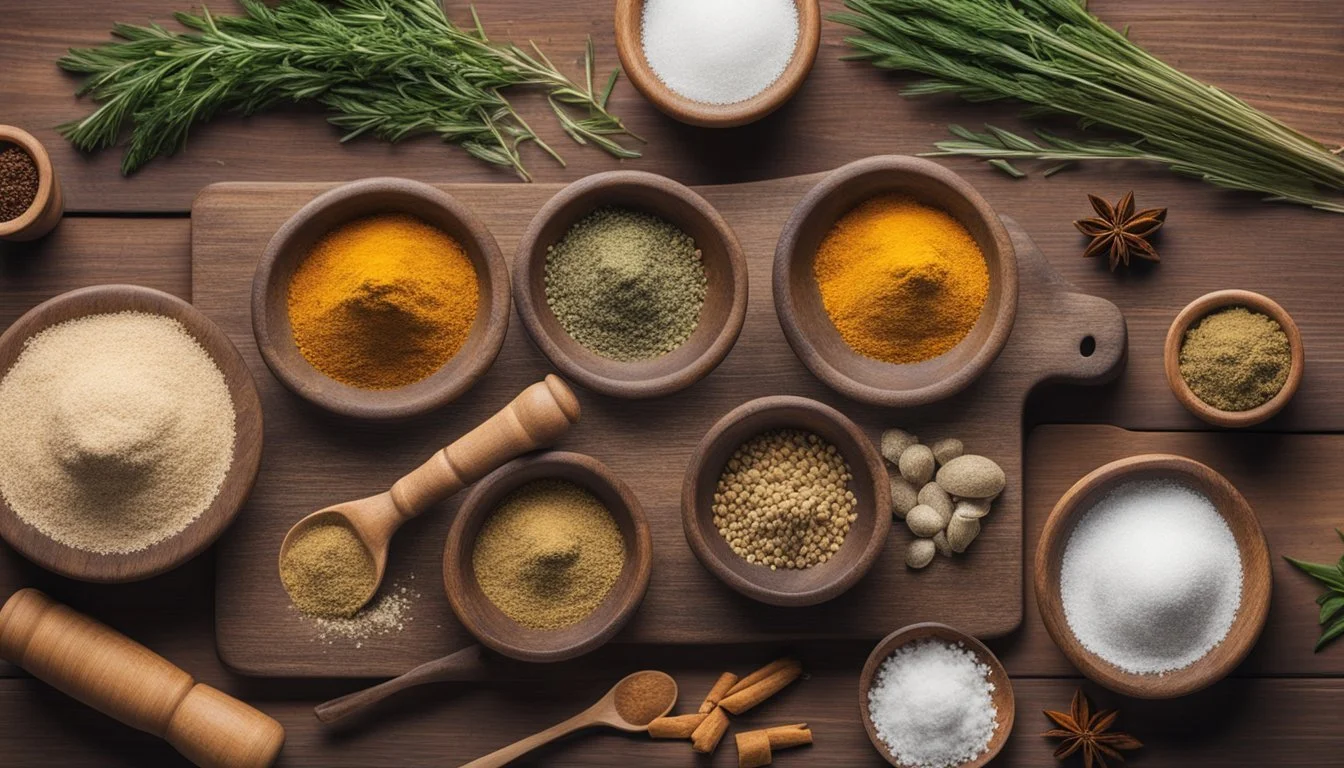How to Make Your Own Dry Rubs for Barbecue
Mastering Homemade Spice Blends
Creating a homemade dry rub is a simple and effective way to add intense flavor to barbecue fare. A dry rub consists of a blend of herbs, spices, salts, and sugars that can be tailored to enhance the natural taste of meats and vegetables prepared on the grill. While pre-made mixes are readily available, crafting a personal rub allows for customization and can complement specific cuts of meat, personal dietary needs, and unique flavor preferences.
The cornerstone of a good dry rub is understanding the balance of its core components. Salts are essential for their ability to draw moisture to the surface of the meat and form a crisp, seasoned crust, while sugars caramelize under heat, lending a satisfying sweetness that contrasts nicely with smoky barbecue (What wine goes well with barbecue?) flavors. Herbs and spices complete the mixture, introducing aromatic notes and depth that range from earthy to spicy depending on the selection. When properly combined, these elements work together to elevate any barbecue dish from ordinary to extraordinary.
For enthusiasts looking to enhance their barbecue dishes, the creation of a homemade dry rub is a journey of flavor exploration. Experimentation is encouraged, as it can lead to distinctive rubs that are suited for different proteins – from beef to pork, chicken to fish – and can reflect a diversity of regional barbecue styles. The precision of a homemade mix not only guarantees fresh, potent flavors but also allows grill masters to take full control of their culinary creations, ensuring each barbecue meal is a showcase of their unique taste.
Understanding Dry Rubs
Dry rubs are essential for creating complex flavor profiles and can transform the barbecue experience. The following subsections delve into what dry rubs are, their significance in barbecuing, and the different types available.
Defining Dry Rubs
A dry rub is a mixture of spices and seasonings applied to the surface of meat before cooking. It typically consists of a combination of salt, sugar, and a variety of ground herbs and spices that adhere to the meat's surface. The primary function of a dry rub is to impart flavor and sometimes, to a lesser extent, tenderize the meat.
Importance in Barbecuing
In barbecuing, a dry rub adds a flavorful crust or bark to the meat during the long cooking process. The rub serves not only to enhance the taste but also to form a barrier that helps retain the meat’s natural juices. Proper application can elevate the final dish to a level that marinades and sauces alone often cannot achieve.
Varieties of BBQ Rubs
BBQ rubs can range in flavor from sweet to spicy, or earthy to aromatic, depending on the ingredients used. Some common components include:
Sweet: Brown sugar, honey powder
Savory: Garlic powder, onion powder
Spicy: Cayenne pepper, chili powder
Earthy: Cumin, paprika
Herbaceous: Thyme, oregano
These ingredients can be mixed in countless combinations, allowing the cook to tailor the rub to the specific type of meat or desired flavor profile of the barbecue dish.
Selecting Ingredients
Creating a dry rub for barbecue requires selecting quality ingredients that balance savory, sweet, and spicy elements. Each component plays a crucial role in flavor development and can enhance the natural taste of meats.
Choosing the Right Salt
Salt is foundational in a dry rub, as it enhances flavors and assists in moisture retention. Kosher salt is a popular choice for its coarse texture and ability to distribute evenly. For finer textures, table salt can be employed, but one should adjust quantities due to its denser nature.
Sweetening Agents
Sweetness balances a rub's heat and saltiness. Brown sugar is commonly used for its deep, molasses-like sweetness, which complements smoky flavors. Granulated sugar is an alternative that can contribute a lighter sweet profile without the additional moisture of brown sugar.
Herbs and Spices
A well-rounded dry rub contains a variety of herbs and spices. Key players include:
Paprika for color and mild warmth
Cumin for an earthy note
Garlic powder and onion powder for a savory touch
Chili powder, black pepper, and cayenne pepper for heat
Dry mustard for tanginess
Incorporating a balance of these can tailor a rub to specific tastes or cuisines.
Balancing Flavors
The art of a good dry rub lies in the balance of sweet, savory, and spicy components, creating a harmonious flavor profile. Start with equal parts of salt and sugar, then adjust to taste while methodically adding spices like garlic, onion, cayenne, and others accordingly. The goal is to compliment the meat without overpowering it.
Creating Your Signature Rub
Creating a signature rub revolves around understanding the harmony of flavors, the specific cuts of meat you're seasoning, and how sugar reacts during cooking. A tailor-made rub can elevate the taste of beef brisket, (What wine goes well with beef brisket?) pork ribs, (What wine goes well with pork ribs?) chicken, or even seafood to new heights.
Experimenting with Different Spices
One begins by choosing a base of salt and pepper and then builds complexity through various spices. For beef, one might add paprika for smokiness or cumin for earthiness. When seasoning pork, especially cuts like pork butt or pork shoulder, a chef could introduce fennel (how long does fennel last?) or sage to complement the meat's natural flavors. Chicken benefits from lighter spices such as thyme or coriander. With fish and seafood, a cook could opt for delicate herbs such as dill or tarragon.
Beef (brisket, steak): Paprika, Cumin
Pork (ribs, pulled pork, pork butt): Fennel, Sage
Chicken: Thyme, Coriander
Fish/Seafood: Dill, Tarragon
Adjusting for Meat Types
The type of meat dictates the rub's flavor profile and spice levels. Beef, with its robust flavor, stands up well to stronger spices and herbs. Brisket and steak may benefit from a bolder rub that can include garlic or onion powder for additional depth. Pork is versatile and can handle a blend that's both sweet and spicy, augmenting the natural juiciness of ribs or pork shoulder. Chicken, being a milder meat, requires a careful balance to avoid overpowering it. For fish or lamb, one should typically use lighter, more aromatic herbs and seasonings to complement these meats.
Beef: Garlic Powder, Onion Powder
Pork: Brown Sugar, Cayenne Pepper
Chicken: Paprika, Garlic Powder
Fish/Lamb: Lemon Zest, Dill
The Role of Sugar
Sugar is a critical component of many rubs, contributing to caramelization and a desirable crust. Brown sugar melds well with pork, enhancing the meat's natural sweetness, and can turn a simple pork butt into a succulent, flavorful pulled pork feast. White sugar is less desirable due to its tendency to burn at high temperatures, whereas brown sugar caramelizes nicely. For ribs and brisket, a touch of sugar balances heat and supports the formation of a delectable bark.
Pork: Brown Sugar (enhances sweetness, good for caramelization)
Ribs/Brisket: Touch of Sugar (balances heat, aids in bark formation)
When crafting a signature rub, one considers the spices' compatibility with the chosen meat and the role of sugar in the cooking process to develop a specific taste profile that is uniquely theirs.
Application Techniques
Achieving the perfect barbecue involves more than just mixing spices; how one applies the dry rub to the meat is crucial for flavor development and texture. The following techniques ensure a well-coated, flavorful, and moist result with the desirable bark that enthusiasts strive for.
Proper Coating and Marinating
A thorough application of your dry rub is essential for an even flavor profile. Generously coat all sides of the meat, rubbing the spices in with your hands to ensure full coverage. Marinating time can range from 30 minutes to overnight in the refrigerator; however, larger cuts of meat benefit from longer marinating times to allow the flavors to penetrate deeply.
Oil Use in Rubs
Applying a thin layer of oil on the meat before coating it with the dry rub can enhance the spices' adherence and create a barrier that locks in moisture during grilling. Oils with a higher smoke point, such as canola or vegetable oil, are preferred as they withstand the high temperatures of grilling without burning.
Creating a Bark
The coveted 'bark'—a crispy and flavorful crust on smoked meats (What wine goes well with smoked meats?)—forms when the right combination of seasoning, moisture, and smoke converge. For an optimal bark, maintain consistent humidity in the grill; this can be achieved by utilizing a water pan. Additionally, refrain from wrapping the meat in foil during the initial smoking phase, as this can soften the bark.
Storage and Shelf Life
Proper storage extends the potency and freshness of homemade dry rubs considerably. For the best result, one should focus on airtight containers, shelf stability, and accurate labeling and date tracking.
Airtight Containers
The use of airtight containers is essential in preserving the quality of dry rubs. These containers prevent moisture and air from compromising the rub's flavor. They should ideally be stored in a pantry or any cool, dark environment to maintain freshness longer. Materials such as glass or food-grade plastic are suitable choices for storage.
Shelf Stability
Dry rubs remain fresh and maintain their potency typically for 1-2 years if stored correctly. Factors that affect shelf stability include temperature, humidity, and exposure to light. Therefore, it is critical to store the rub in a place that is consistently cool and dry, away from heat sources and direct sunlight, to prevent degradation.
Labeling and Date Tracking
To ensure that rubs are used when their flavor is at its peak, labeling and date tracking are recommended. Labels should include the name of the rub and the date it was created. An easy-to-read label helps track usage and prevents the confusion of contents, especially if multiple rubs are stored in the pantry. This method also facilitates better inventory management and timely use.
Health and Nutrition Considerations
When crafting homemade dry rubs for barbecue, the health and nutritional impact of each ingredient should not be overlooked. Sodium and caloric content can vary widely, and choosing healthier ingredients can significantly improve the nutritional profile of your rubs.
Caloric and Sodium Content
Dry rubs generally contain a mix of spices and seasonings which can influence the caloric and sodium content of the end dish. Sodium is a notable component, primarily from table salt, which can contribute to high blood pressure if consumed in excessive amounts. The American Heart Association recommends no more than 2,300 milligrams a day and moving toward an ideal limit of 1,500 mg per day for most adults.
Salt: One teaspoon of table salt contains about 2,300 mg of sodium.
Sugar: Often used in rubs, sugars add to the overall caloric count. One teaspoon of sugar has about 16 calories.
It's crucial that those mindful of their sodium intake measure carefully and consider using salt substitutes like potassium chloride if needed.
Choosing Healthier Ingredients
Selecting components rich in nutrients can enhance both the flavor and health quotient of your dry rub.
Herbs and Spices: Fresh or dried herbs add flavor without calories and offer health benefits. For example:
Garlic powder helps with cholesterol levels.
Paprika can provide vitamin A.
Potassium-Rich Additives: Substitute a portion of salt with potassium chloride to maintain taste while reducing sodium content.
To improve the nutritional value, one may consider the following:
Ingredient Benefit Turmeric Contains curcumin which may have anti-inflammatory properties. Cumin May aid in digestion and contains a small amount of iron. Chili Powder Rich in antioxidants and may offer a small amount of vitamin C.
Incorporating ingredients like these not only boosts the flavor profile but can also contribute to your daily recommended intake of certain nutrients, like calcium and iron, depending on their usage. It remains imperative to use these ingredients judiciously, as spices can be potent and overpowering in large quantities.
Complementing Your BBQ
In crafting the perfect BBQ, understanding the symbiosis between dry rubs and barbecue sauces is essential. Rubs form the base layer of flavor, while the right sauce can enhance and harmonize with these tastes, creating a complex and satisfying experience.
Pairing with Barbecue Sauces
When pairing dry rubs with barbecue sauces, chefs must consider the flavor profiles of each component. A classic, richly flavored dry rub can be perfectly balanced with a sweet and tangy barbecue sauce, ensuring neither overpowers the other. Barbecue sauces that possess a sour element can cut through the spice and smokiness of the rub, giving a fresh lift to dishes. A versatile approach allows for adjusting the sweetness or acidity of the barbecue sauce to match the boldness of the dry rub, creating a harmonious and flavorful pairing.
Sweet Rubs: Complement with spicy or vinegary sauces for balance.
Spicy Rubs: Pair with sweet, fruity sauces to temper the heat.
By contrasting flavors, one can achieve a taste that's both complex and pleasing to the palate.
Choosing Rubs for Different Dishes
Different proteins and vegetables require specific rubs for best results. A sugar-based rub tends to caramelize and is ideal for pork, enhancing the natural flavors with a touch of sweetness. On the other hand, beef generally benefits from a savory rub with a higher salt content, often combined with herbs and garlic for depth. Vegetables are incredibly versatile, but they shine with a light rub that might include citrus zest or herbs, which doesn’t overpower their natural taste.
For pork: Utilize a balance of sweetness and spice.
For beef: Opt for bold and savory flavors.
Vegetables: Use lighter rubs that complement without dominating.
By choosing the right rub for the dish, chefs can enhance the natural qualities of the food, ensuring that every bite is packed with flavor.
Advanced Techniques and Secret Tips
Crafting your own barbecue rubs is an art that requires precision, insight, and a flair for flavor. Understanding the advanced techniques and uncovering secret tips can significantly elevate your homemade spice blends.
Layering Flavors
Layering flavors is essential in creating a complex and harmonious barbecue rub. Begin with a balanced base of salts and sugars, then incorporate a variety of spices. For depth, add:
Ground Black Pepper: Essential for a warming heat.
Smoked Paprika: Imparts a subtle smokiness.
Mustard Powder: Offers tanginess that can cut through rich meats.
Dark Brown Sugar vs. White Sugar: Dark brown sugar adds a molasses-like depth while white sugar provides a cleaner sweetness that allows other flavors to shine.
Homemade vs. Store-Bought
Homemade spice blends allow for customization and freshness. In contrast, store-bought rubs provide convenience and consistency. When making your rub:
Opt for fresh spices to ensure a robust flavor.
A mason jar is an ideal storage container to keep your rub airtight and flavorful.
Homemade blends can be tailored to dietary restrictions, such as lower salt or sugar content.
Discovering Your Secret Ingredient
Each barbecue master has a secret ingredient that sets their rub apart:
Experiment with unconventional spices like white pepper or oregano.
Incorporate unique flavors like celery seed or ginger in small quantities.
The key is to add something unexpected that complements the main profile of your rub.
Regional Styles and Influence
Regional barbecue styles can inspire your rub recipes:
Memphis Style: Known for rib rubs heavy on paprika and garlic.
Texas Style: Emphasizes bold flavors like cumin and chile powder, focusing on beef.
Use these regional influences as a guideline, but don't be afraid to put a personal twist to suit your palate.





